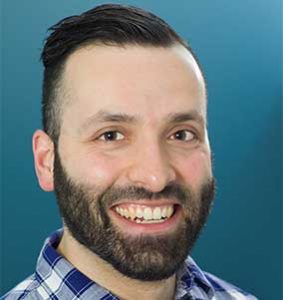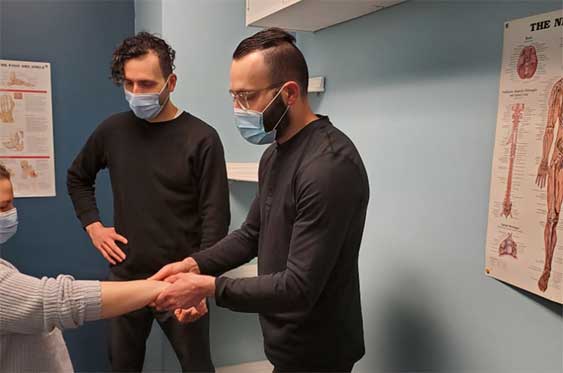By Dr. Paolo De Ciantis |
From managing low back pain through Rapid Access Clinics to helping patients get off opioids, the impact of how multidisciplinary teamwork helps our patients can’t be denied. We see the value of collaboration play out every day for patients visiting our sports-based practice. There, we help a range of needs, from athletes to patients with chronic conditions like Parkinson’s disease.
A Profession Based on Research and Patient Care
My entry into chiropractic was a little serendipitous. During my master’s degree at McMaster University, Dr. Howard Vernon happened to be working with one of my research supervisors to develop a bone model. At the time, I didn’t realize that there was a huge evidence-based approach in chiropractic, with many research opportunities.
The chiropractic profession caught my attention because I can work hands-on with patients to provide almost immediate relief to a person’s physical pain. It’s also an opportunity to conduct research that helps other health care professionals throughout the world, as well as improving patient care directly.
Teamwork Helps Our Patients Benefit from Multiple Specialities
I graduated from CMCC in 2013, following my twin brother who motivated me to get into chiropractic care. We then took over a sports-based practice at the intersection of Bayview and York Mills, in Toronto.
Our clinic, Sports Specialist Rehab Centre, recognizes that patient care requires a team effort. Of course, my skills as a chiropractor are valuable, but I’m nothing without my team. My colleagues include a physiotherapist, acupuncturist, naturopathic doctor, kinesiologist and registered massage therapist. And, our health care network is extensive, from medical doctors to rheumatologists to plastic surgeons. I believe true patient-centered care lies in the combination of our specialties.
Our clinic’s goal is to work together to get people mobile and healthy again.
Keeping People Active and Pain-free
We’re not solely a sports practice. We see a variety of patients – from 16-year-old athletes to 55-year-old retirees. With every individual, we do a thorough medical history, physical assessment and provide diagnosis. Then, with the patient’s permission, we begin treatment.
Treatment usually involves a general approach to:
- Address the patient’s pain
- Restore function to their muscles and joints
- Get them active and engaged in their own care, so that they can get back to their day-to-day lives
I want to highlight a patient referred to me, who had Parkinson’s disease for about 40 to 50 years. She was on a drug regimen but had not been given any physical therapy, rehab or direction for ‘how’ to stay active. So, we helped her with strengthening her muscles, enhancing her range of motion and getting her moving. It was really inspiring and humbling for me to see how hard she worked and how she never gave up. This patient was determined to stay as independent as possible in the latter part of her life.
Giving People the Tools to Stay Healthy
For someone with a sports injury, we follow much the same process: conduct a thorough history, physical assessment and provide the diagnosis.
For treatment however, we typically go through these steps:
- We recommend the patient takes a break from their sports activities. Then we apply pain control therapy, such as electrical stimulation and acupuncture, as required.
- We work on the joint and soft tissue problems with hands-on joint and muscle stretching techniques.
- As the patient’s pain goes down, and their range of motion increases, we ramp up with a lot of rehab work, like mobility and strength training.
- At the very end, we do sports specific training for each athlete. For example, if the patient is a soccer player, this would include kicking mechanics.
Keep Doing What Got You Out of Pain, to Stay Out of Pain
Almost daily, we remind patients to: “Keep taking the steps to minimize your injury minimization, or the rehab we provide, even if you’re not in pain.” For example, if an office worker has pain related to sitting for long periods of time, I’ll always give them a lumbar spine mobilization activity. One would be, gently bending over and twisting their spine periodically throughout the workday. Once our treatment plan gets them out of pain, we know continuing to do these exercises on their own will help minimize the likelihood of them aggravating the issue.
I argue that probably the most important thing a patient can do is to keep doing the rehab instructions we provide, even after it stops hurting them.
We Use a Team Approach – Inside and Outside the Office
During the assessment, diagnosis and initial treatment stages, we work as a team to determine if we need a specialist in another area of expertise, if they haven’t been involved already. With the patient’s permission, we start contacting these professionals directly, writing letters and compiling information, so we can have a discussion to collectively decide the best course of action.
After we’ve had established some of these networks, we get direct referrals from some medical professionals. When I get a referral from any physician that I know, they will get a detailed writeup or phone call to stay informed about our patient’s care. We provide them with our thoughts on the diagnosis and even let them know, “Hey, I might need an MRI. We may need a rheumatologist referral. Let’s keep this or that in mind in case treatment doesn’t go the way that we want.” This collaborative teamwork helps our patients and delivers multiple benefits.
Teaching and Supporting: Students, Athletes and those in Need
Our team works extensively with community organizations. In fact, there are three soccer organizations: Toronto Skillz FC, Scarborough Women’s GS United, and West Toronto United, which we work with directly. Doing things like injury treatment, injury prevention protocols and injury rehab. We have also worked directly with the Parkinson Canada – Markham and Stouffville Support Group, and even the Canadian Arm-wrestling Federation.
I personally work with four high schools’ officially accredited co-op programs in the area. Every year we have one to three co-op students in the office that we teach directly every day.
At Sports Specialist Rehab Centre, we have a diverse set of skills with which we collaborate towards patient-centered care. We focus on getting people out of pain and back to their lives with tools to maintain their own health. Giving back to, and working with, our community, is at the core of our clinic’s day-to-day operations.
If you live outside Toronto, use OCA’s Chiropractor locator to find a chiropractor with a similar expertise and approach near you.
If you are in the GTA and are a new patient, you can book online at http://www.sportsrehabto.com or by dropping by our office at 300 York Mills Road. However, I find that a phone call is best. That way, all the pertinent information is communicated and any questions can be addressed. If you have any questions, I can be reached at 416-385-0110.
(Originally posted by the Ontario Chiropractic Association)

